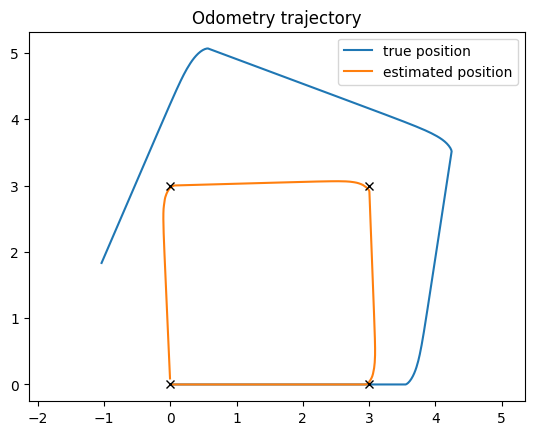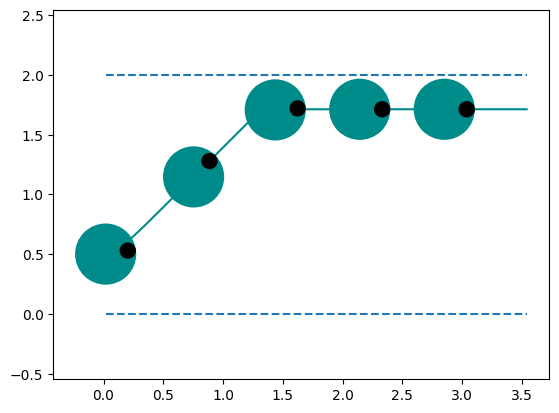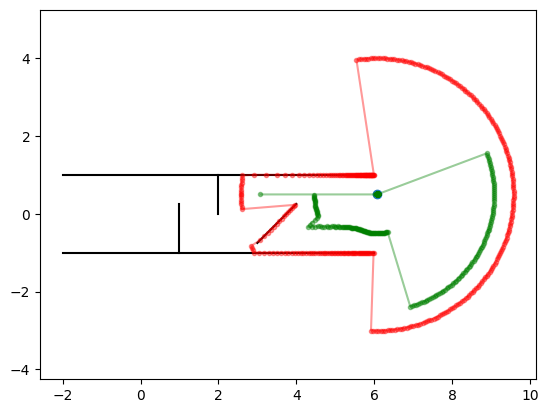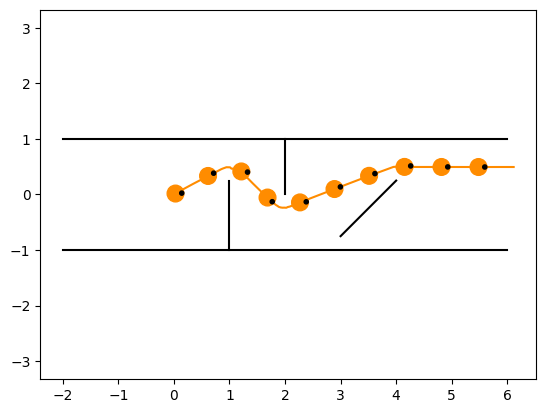Sensors#
This notebook shows examples of sensors and navigation behaviors using them.
Odometry#
[1]:
from navground import core, sim
from navground.sim.ui.video import display_video_from_run, record_video_from_run
[2]:
import numpy as np
exp = sim.load_experiment("""
steps: 1000
time_step: 0.1
record_pose: true
scenario:
groups:
- type: thymio
color: darkcyan
number: 1
radius: 0.25
orientation: 0
speed_tolerance: 0.1
kinematics:
type: 2WDiff
max_speed: 1.0
wheel_axis: 0.5
behavior:
type: Dummy
optimal_speed: 0.5
task:
type: Waypoints
waypoints: [[3, 0], [3, 3], [0, 3], [0, 0]]
loop: false
tolerance: 0.1
state_estimation:
type: Odometry
angular_speed_bias: 0.1
angular_speed_std_dev: 0.2
longitudinal_speed_bias: -0.2
longitudinal_speed_std_dev: 0.2
transversal_speed_bias: 0
transversal_speed_std_dev: 0.05
update_ego_state: true
update_sensing_state: false
""")
class OdomProbe(sim.RecordProbe):
dtype = float
def update(self, run: sim.ExperimentalRun) -> None:
for agent in run.world.agents:
self.data.append(np.array(agent.behavior.position))
def get_shape(self, world: sim.World) -> list[int]:
return [len(world.agents), 2]
exp.add_record_probe("odom/poses", OdomProbe)
[3]:
run = exp.run_once(0)
[4]:
run.records
[4]:
{'odom/poses': <Dataset: shape (314, 1, 2), dtype float64>,
'poses': <Dataset: shape (314, 1, 3), dtype float32>}
[5]:
from matplotlib import pyplot as plt
from navground.sim.pyplot_helpers import plot_run
odom_poses = np.asarray(run.get_record("odom/poses"))
plt.plot(run.poses[:, 0, 0], run.poses[:, 0, 1], label="true position")
plt.plot(odom_poses[:, 0, 0], odom_poses[:, 0, 1], label="estimated position")
for p in run.world.agents[0].task.waypoints:
plt.plot(*p, 'kx')
plt.legend()
plt.title("Odometry trajectory")
plt.axis('equal');

[6]:
def render_trace(points: list[core.Vector2], color: str, width: float = 0.03, opacity: float = 0.5) -> str:
svg_point = " ".join([f"{x:.4f},{y:.4f}" for x, y in points])
return f'<polyline points="{svg_point}" fill="none" stroke="{color}" stroke-width="{width}" stroke-opacity="{opacity}"/>'
positions = run.poses[:, 0, :2]
odom_positions = np.asarray(run.get_record("odom/poses"))[:, 0, :2]
def render_traces(world: sim.World) -> str:
return "\n".join([
render_trace(positions[:world.step], color='black'),
render_trace(odom_positions[:world.step], color='orange')])
display_video_from_run(run, factor=3, width=1280, extras=[render_traces])
[6]:
[7]:
record_video_from_run("../components/state_estimations/odometry.mp4", run, factor=3, width=1280, extras=[render_traces])
Boundary#
[8]:
import numpy as np
from navground import core, sim
class StayAwayFromBoundary(core.Behavior, name="StayAwayFromBoundary"):
def __init__(self, kinematics: core.Kinematics | None = None, radius: float = 0.0):
core.Behavior.__init__(self, kinematics, radius)
self._state = core.SensingState()
def get_environment_state(self) -> core.EnvironmentState:
return self._state
def desired_velocity_towards_velocity(self, velocity: core. Vector2, time_step: float) -> core.Vector2:
d1, d2 = self._state.buffers['boundary_distance'].data
r = self.radius + self.safety_margin
if d1 < r or d2 < r:
velocity[1] = 0
return velocity
def desired_velocity_towards_point(self, point: core.Vector2, speed: float, time_step: float) -> core.Vector2:
delta = point - self.pose.position
distance = np.linalg.norm(delta)
if distance:
return self.desired_velocity_towards_velocity(
speed * delta / distance, time_step)
return np.zeros(2)
[9]:
exp = sim.load_experiment("""
steps: 200
time_step: 0.1
record_pose: true
scenario:
bounding_box:
min_y: 0
max_y: 2
min_x: -1
max_x: 5
groups:
- type: thymio
color: darkcyan
number: 1
radius: 0.25
control_period: 0.1
orientation: 0
position: [0, 0.5]
kinematics:
type: 2WDiff
max_speed: 1.0
wheel_axis: 0.5
behavior:
type: StayAwayFromBoundary
optimal_speed: 0.25
safety_margin: 0.1
task:
type: Direction
direction: [1, 1]
state_estimation:
type: Boundary
min_y: 0
max_y: 2
""")
[10]:
run = exp.run_once(0)
[11]:
from matplotlib import pyplot as plt
from navground.sim.pyplot_helpers import plot_run
ax = plt.subplot()
bb = run.world.bounding_box
ax.hlines([bb.min_y, bb.max_y], min(run.poses[..., 0]), max(run.poses[..., 0]), linestyle="dashed")
plot_run(ax, run=run, step=40, with_agent=True)
plt.axis('equal');

[12]:
run.world.bounding_box
[12]:
BoundingBox(min_x=-1.0, max_x=5.0, min_y=0.0, max_y=2.0)
[13]:
def render_boundary(world: sim.World) -> str:
s = ''
x1 = world.bounding_box.min_x
x2 = world.bounding_box.max_x
for y in (world.bounding_box.min_y, world.bounding_box.max_y):
s += f'<line x1="{x1}" y1="{y}" x2="{x2}" y2="{y}" stroke="blue" stroke-width="0.01" stroke-dasharray="0.1" />'
return s
[14]:
display_video_from_run(run, factor=3, width=1280, extras=[render_boundary])
[14]:
[15]:
record_video_from_run("../components/state_estimations/boundary.mp4", run, factor=3, width=1280, extras=[render_boundary])
Lidar#
[16]:
import numpy as np
from navground import core, sim
import math
def distance_from_target(angle: float, free_range: float, horizon: float) -> float:
d = math.cos(angle) * horizon
if d < 0:
return horizon
if d < free_range:
return abs(math.sin(angle) * horizon)
return math.sqrt(horizon ** 2 + free_range ** 2 - 2 * free_range * d)
def dilate_ranges(ranges: np.ndarray, by: float, fov: float):
d_ranges = np.array(ranges)
for i, r in enumerate(ranges):
alpha = math.asin(min(by / r, 1))
di = math.ceil(alpha / fov * len(ranges))
i0 = max(i - di, 0)
d_ranges[i0: i + di] = np.minimum(max(0, r - by), d_ranges[i0: i + di])
return d_ranges
class BehaviorUsingLidar(core.Behavior, name="UsingLidar"):
def __init__(self, kinematics: core.Kinematics | None = None, radius: float = 0.0):
core.Behavior.__init__(self, kinematics, radius)
self._state = core.SensingState()
self._eta = 0.5
@property
def eta(self) -> float:
return self._eta
def get_environment_state(self) -> core.EnvironmentState:
return self._state
def desired_velocity_towards_velocity(self, velocity: core. Vector2, time_step: float) -> core.Vector2:
speed = np.linalg.norm(velocity)
if speed:
p = self.position + velocity / speed * self.horizon
return self.desired_velocity_towards_point(p, speed, time_step)
return np.zeros(2)
def desired_velocity_towards_point(self, point: core.Vector2, speed: float, time_step: float) -> core.Vector2:
target_angle = core.orientation_of(point - self.position)
opt_angle = 0.0
opt_distance = self.horizon
opt_free_range = -1.0
ranges = self._state.buffers["range"].data
fov = float(self._state.buffers["fov"].data[0])
s = float(self._state.buffers["start_angle"].data[0]) + self.orientation
angles = np.linspace(s, s + fov, len(ranges))
ranges = dilate_ranges(ranges, self.radius + self.safety_margin, fov)
for angle, free_range in zip(angles, ranges):
theta = angle - target_angle
dist = distance_from_target(theta, free_range, self.horizon)
if dist < opt_distance:
opt_angle = angle
opt_free_range = free_range
opt_distance = dist
if opt_distance >= self.horizon:
return np.zeros(2)
desired_speed = min(speed, opt_free_range / self.eta)
return desired_speed * core.unit(opt_angle)
[17]:
exp = sim.load_experiment("""
steps: 200
time_step: 0.0333
record_pose: true
record_sensing:
- agent_indices: [0]
scenario:
walls:
- line: [[-2, -1], [6, -1]]
- line: [[-2, 1], [6, 1]]
- line: [[1, -1], [1, 0.25]]
- line: [[2, 0.0], [2, 1]]
- line: [[3, -0.75], [4, 0.25]]
groups:
- type: quadrotor
color: darkorange
number: 1
radius: 0.15
orientation: 0
kinematics:
type: Omni
max_speed: 1
max_angular_speed: 10.0
behavior:
type: UsingLidar
horizon: 5
safety_margin: 0.1
heading: velocity
rotation_tau: 0.25
task:
type: Direction
direction: [1, 0]
state_estimation:
type: Lidar
range: 3.5
start_angle: -3.14
field_of_view: 6.28
resolution: 360
""")
[18]:
from navground.sim.notebook import display_in_notebook
display_in_notebook(exp.scenario.make_world())
[18]:
[19]:
run = exp.run_once(0)
[20]:
run.get_records("sensing")
[20]:
{'0/fov': <Dataset: shape (200, 1), dtype float32>,
'0/max_range': <Dataset: shape (200, 1), dtype float32>,
'0/range': <Dataset: shape (200, 360), dtype float32>,
'0/start_angle': <Dataset: shape (200, 1), dtype float32>}
[21]:
from matplotlib import pyplot as plt
from navground.sim.pyplot_helpers import plot_world
behavior = run.world.agents[0].behavior
state = behavior.environment_state
ranges = state.get_buffer('range').data
start = state.get_buffer('start_angle').data[0] + behavior.orientation
fov = state.get_buffer('fov').data[0]
angles = np.linspace(start, start + fov, len(ranges))
d_ranges = dilate_ranges(ranges, 0.5, fov)
ps = np.asarray([core.unit(angle) * r + behavior.position for angle, r in zip(angles, ranges)])
d_ps = np.asarray([core.unit(angle) * r + behavior.position for angle, r in zip(angles, d_ranges)])
c = behavior.position
ax = plt.subplot()
ax.plot(*c, 'o');
ax.plot(ps[:, 0], ps[:, 1], 'r.-', alpha=0.4)
ax.plot(d_ps[:, 0], d_ps[:, 1], 'g.-', alpha=0.4)
plot_world(ax, run.world)
plt.axis('equal');

[22]:
from matplotlib import pyplot as plt
from navground.sim.pyplot_helpers import plot_run
ax = plt.subplot()
plot_run(ax, run=run, step=20, with_agent=True)
plt.axis('equal');

[23]:
display_video_from_run(run, factor=1, width=1280)
[23]:
[24]:
def render_scan(pose: core.Pose2, ranges: np.ndarray, start_angle: float, fov: float, color: str) -> str:
a = start_angle + pose.orientation
angles = np.linspace(a, a + fov, len(ranges))
svg = ''
ps = [core.unit(angle) * r + pose.position for angle, r in zip(angles, ranges)]
points = " ".join([f"{x:.4f},{y:.4f}" for x, y in ps])
return f'<polyline points="{points}" fill="none" stroke="{color}" stroke-width="0.05" stroke-opacity="0.2"/>'
def render_scan_state(pose: core.Pose2, state: core.SensingState, color: str) -> str:
return render_scan(
pose, state.get_buffer('range').data,
state.get_buffer('start_angle').data[0],
state.get_buffer('fov').data[0], color)
def scan_renderer(*args, **kwargs) -> str:
def f(world: sim.World) -> str:
return "\n".join(
render_scan_state(agent.pose, agent.behavior.environment_state, *args, **kwargs)
for agent in world.agents)
return f
[25]:
display_video_from_run(run, factor=1, extras=[scan_renderer(color="red")], display_width=720, width=1280)
[25]:
[26]:
record_video_from_run("../components/state_estimations/lidar.mp4", run, factor=1,
width=1280, extras=[scan_renderer(color="red")])
Local gridmap#
[27]:
import numpy as np
exp = sim.load_experiment(f"""
steps: 600
time_step: 0.033
record_pose: true
record_sensing:
- agent_indices: [0]
scenario:
walls:
- line: [[-10, -6], [10, -6]]
- line: [[-10, -6], [-10, 6]]
- line: [[10, -6], [10, 6]]
- line: [[-10, 6], [10, 6]]
- line: [[-8, -4], [8, -4]]
- line: [[-8, -4], [-8, 4]]
- line: [[8, -4], [8, 4]]
- line: [[-8, 4], [8, 4]]
- line: [[-5, 6], [-6, 5.5]]
- line: [[-6, 5.5], [-7, 6]]
groups:
- type: wheelchair
color: darkorange
number: 1
radius: 0.25
orientation: 3.14
position: [0, 5]
kinematics:
type: 2WDiff
max_speed: 1
wheel_axis: 0.5
behavior:
type: Dummy
environment: Sensing
task:
type: Path
points: [[-9, -5], [9, -5], [9, 5], [-9, 5], [-9, -5]]
tolerance: -1
state_estimations:
- type: Lidar
name: lidar
resolution: 1001
range: 10
start_angle: {-np.pi}
field_of_view: {2 * np.pi}
error_std_dev: 0.02
- type: Odometry
name: odom
- type: LocalGridMap
height: 300
width: 300
resolution: 0.02
name: gridmap
external_lidars: [lidar]
external_odometry: odom
- type: human
color: red
number: 5
radius: 0.2
orientation: 3.14
position: [[8, -5], [5, -5], [2, -5], [-1, -5], [-4, -5]]
kinematics:
type: Ahead
max_speed: 1
max_angular_speed: 10.0
behavior:
type: HL
horizon: 10
task:
type: Path
points: [[-9, 5], [9, 5], [9, -5], [-9, -5], [-9, 5]]
tolerance: -1
state_estimation:
type: Bounded
range: 10
""")
[28]:
from navground.sim.notebook import display_in_notebook
display_in_notebook(exp.scenario.make_world(), width=500)
[28]:
[29]:
run = exp.run_once(0)
[30]:
import moviepy as mpy
from navground.sim.ui.video import display_video_from_run, make_video_from_run
import numpy as np
def make_grid_map_video(run,
agent_index = 0,
name: str = '',
factor = 1,
period = 0.033):
data = np.asarray(run.records[f'sensing/{agent_index}/{name}/local_gridmap'])
images = data
duration = len(data) * period / factor
def make_frame(t: float):
i = int(t / period * factor)
i = np.clip(i, 0, len(images) - 1)
return np.repeat(images[i][::-1, :, np.newaxis], 3, axis=-1)
return mpy.VideoClip(make_frame, duration=duration)
gridmap_clip = make_grid_map_video(run, 0, name='gridmap', factor=1)
world_clip = make_video_from_run(run, factor=1).resized((500, 300))
gridmap_clip.pos = lambda _: (500, 0)
img = mpy.ImageClip(np.full((300, 800, 3), 255, dtype=np.uint8), duration=0)
cc = mpy.CompositeVideoClip(clips=[img, world_clip, gridmap_clip])
cc.display_in_notebook(fps=30, width=800, rd_kwargs=dict(logger=None))
[30]:
[31]:
cc.write_videofile("../components/state_estimations/local_gridmap.mp4", fps=30, logger=None)
Marker#
[32]:
from navground import core, sim
import numpy as np
import shapely
class SlowDownNearMarkerBehaviorModulation(core.BehaviorModulation, name="SlowDown"):
def pre(self, behavior: core.Behavior, time_step: float) -> None:
x = behavior.environment_state.buffers['slow_down/x'].data[0]
y = behavior.environment_state.buffers['slow_down/y'].data[0]
if abs(x) < 10 and abs(y) < 5:
behavior.target_ref.speed = behavior.optimal_speed / 4
else:
behavior.target_ref.speed = behavior.optimal_speed
def draw_road(points: list[core.Vector2], road_width: float):
def f(world: sim.World) -> str:
ps = " ".join([f"{x:.4f},{y:.4f}" for x, y in points])
return f'<polyline points="{ps}" fill="none" stroke="darkgrey" stroke-width="{road_width}"/>'
return f
class RoadScenario(sim.Scenario, name="Road"):
def init_world(self, world: sim.World, seed: int | None = None) -> None:
super().init_world(world, seed=seed)
length = 100
width = 20
curvature_radius = 20
road_width = 10
path = shapely.Polygon([[0, 0], [length, 0], [length, width], [0, width]]).buffer(curvature_radius).exterior
l = path.length
points = list(np.array(path.coords))
for agent in world.agents:
if not agent.task:
agent.task = sim.tasks.PathTask(points=points, tolerance=-1)
if agent.pose == core.Pose2():
s = world.random_generator.uniform(0, 1)
ps = np.array(path.interpolate(s, normalized=True).coords[0])
ps1 = np.array(path.interpolate(s + 0.001, normalized=True).coords[0])
delta = ps1 - ps
theta = np.arctan2(delta[1], delta[0])
agent.pose = core.Pose2(ps, theta)
world.render_kwargs['background_extras'] = [draw_road(points, road_width)]
world.bounding_box = sim.BoundingBox(-curvature_radius - road_width / 2, length + curvature_radius + road_width / 2,
-curvature_radius - road_width / 2, width + curvature_radius + road_width / 2)
exp = sim.load_experiment(f"""
steps: 600
time_step: 0.033
record_pose: true
scenario:
type: Road
groups:
- type: car
color: orange
number: 1
radius: 2
kinematics:
type: Bicycle
max_speed: 30
max_steeering: 1
max_backward_speed: 0
axis: 3.5
behavior:
type: Dummy
environment: Sensing
path_look_ahead: 25
path_tau: 0.25
modulations:
- type: SlowDown
enabled: true
state_estimations:
- type: Marker
name: slow_down
marker_position: [50, -20]
""")
[33]:
from navground.sim.ui.video import display_video_from_run, record_video_from_run
def draw_slow_area(world: sim.World):
return f'''
<rect x="40" y="-25" width="20" height="10" fill="red" opacity="0.2"/>
'''
run = exp.run_once(0)
run.world.render_kwargs['background_extras'] += [draw_slow_area]
display_video_from_run(run)
[33]:
[34]:
record_video_from_run("../components/state_estimations/marker.mp4", run, factor=1, width=1280)
